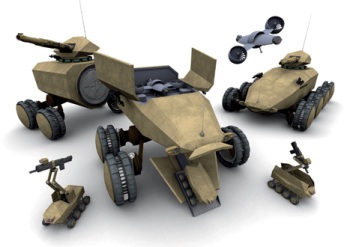United Kingdom’s armed forces have used unmanned aerial vehicles (UAV’s) to perform risky operations like reconnaissance and attack missions, which involves risk to human life.
Among the UAV’s deployed by the armed forces, the Mantis from BAE Systems are used for observation missions and the General Atomics Predator for use of missiles and other weapons are the ones that are often used. BAE is currently developing the future protected vehicle, which is a combination of three unmanned concept vehicles, namely, Pointer, a tracked robot that can take on missions that a single soldier is capable of; Raider, which is a reconfigurable mini war vehicle; Wraith, which is a stealth tank.
 Unmanned Aerial Vehicles (UAV's)
Unmanned Aerial Vehicles (UAV's)
There is a mixed response towards the research activities in developing autonomous vehicles. One group supports research while the other expresses concern over the ethical implications of these activities. The Ministry of Defence’s Development, concepts and doctrine centre (DCDC) has produced a joint doctrine note, which has a whole chapter that lists the legal, moral and ethical issues associated with UAV’s.
Professor Noel Sharkey from the University of Sheffield has expressed concern over the autonomous defence systems, which involve numerous robots that have only one human controlling them. In such cases, he says, it becomes difficult for that person to watch all of them; therefore such missions warrant robots to take control and make decisions. Another professor from the University added that in such missions the information that the operator gets to see is more important and therefore it becomes important to have an interface that selects and displays only the data necessary for quick decision making. Sharkey added that in high speed operations involving UAV’s the operator is able to exercise limited control over them. Hisham Awad, from BAE systems, explained that UAV’s have established their capability of working efficiently in a controlled environment, the team at BAE is therefore working on making the UAV’s competent in handling complex situations. The DCDC report provides additional details into the use of UAV’s in war and eliminating loss of human life. Some other UAV’s that are being developed by DARPA include, Vulture II and Solar Eagle.